Modest Ag-Extension and Access to Seeds of Aromatic Rice Can Boost Returns of Smallholder Farmers in Uganda, A Case Study
Abstract
:1. Introduction
- (a)
- the general public, to promote similar approaches among stakeholders wishing to increase crop productivity among smallholder farmers;
- (b)
- the government to formulate, reform, and implement adopted policies and legislation necessary to support strategies for increasing on-farm crop productivity; and
- (c)
- potential donors interested in supporting strategies to increase on-farm crop productivity.
Project Background
2. Materials and Methods
2.1. Description of the Study Area
2.2. Design of the Study
2.2.1. On-Farm Trial
2.2.2. Field and Crop Management of the On-Farm Trial
2.2.3. Collection and Analysis of On-Farm Trial Data
2.2.4. Seed and Technical Support to Smallholder Farmers
3. Results
3.1. Results of On-Farm Trial
3.2. Case Study Findings
3.2.1. Socio-Economic Status of the Respondents
3.2.2. Outcome of Project Interventions on Farmers’ Rice Yields
3.2.3. Farmers’ Perceptions about Line vs. Random Transplanting
- Line transplanting is expensive, requiring extra labor and a well-puddled and levelled field.
- Line transplanting is cumbersome (it takes a lot of time and effort, it is difficult to measure the spaces between lines, and tiresome to change ropes).
- Line transplanted rice yields less than random transplanted rice because of a lower plant population resulting from seemingly wide spaces between the lines.
- Most farmers do not know how to transplant rice in lines and are unaware of its benefits.
- The wide spaces in line transplanted rice encourage weed growth.
- Line transplanted rice seedlings are eaten more by apple snails (Pomacea spp.), which find it easier to follow and feed along the rows of rice.
- Fertilizers must be applied to line transplanted rice to enhance yields.
3.2.4. Farmers’ Appreciation of NARORICE-1
3.2.5. Challenges Experienced by Farmers in Rice Cultivation
4. Discussion
4.1. On-Farm Trial Findings
4.2. Case Study Findings
4.3. Other Project-Inspired Interventions
5. Conclusions
Author Contributions
Funding
Institutional Review Board Statement
Informed Consent Statement
Acknowledgments
Conflicts of Interest
References
- Barungi, M.; Odokonyero, T. Understanding the Rice Value Chain in Uganda: Opportunities and Challenges to Increased Productivity; Economic Policy Research Centre: Kampala, Uganda, 2016; Volume 15, pp. 1–24. [Google Scholar] [CrossRef]
- Kilimo Trust. Development of Inclusive Markets in Agriculture and Trade (DIMAT): The Nature and Markets of Rice Value Chains in Uganda; UNDP: Kampala, Uganda, 2012; pp. 1–48. Available online: https://www.undp.org/sites/g/files/zskgke326/files/migration/ug/UNDPUg_-PovRed_Value-Chain-Analysis-Report-Cassava-2013-Report.pdf (accessed on 24 May 2022).
- Ministry of Agriculture Animal Industry and Fisheries (MAAIF). Uganda National Rice Development Strategy (NRDS) 2008–2018; MAAIF: Entebbe, Uganda, 2012; pp. 1–87. [Google Scholar]
- Nakaweesi, D. Government Mulls Banning Rice Imports; Daily Monitor: Kampala, Uganda, 2018. [Google Scholar]
- Ayella, P.; Ishii, A.; Satoh, M. A comparative analysis of two paddy irrigation schemes under contrasting water management of participatory and top-down systems in Uganda. Paddy Water Environ. 2019, 17, 497–505. [Google Scholar] [CrossRef]
- Senthilkumar, K.; Rodenburg, J.; Dieng, I.; Vandamme, E.; Sillo, F.S.; Johnson, J.; Rajaona, A.; Ramarolahy, J.A.; Gasore, R.; Abera, B.B.; et al. Quantifying rice yield gaps and their causes in Eastern and Southern Africa. J. Agron. Crop Sci. 2020, 206, 478–490. [Google Scholar] [CrossRef]
- Van Campenhout, B.; Bizimungu, E. Risk and returns of sustainable crop intensification: The case of smallholder rice and potato farmers in Uganda. Dev. Policy Rev. 2017, 36, O605–O633. [Google Scholar] [CrossRef]
- Kijima, Y. Long-term and Spillover Effects of Rice Production Training in Uganda. Work. Pap. 2018, 161, 1–49. [Google Scholar] [CrossRef]
- Odokonyero, T.; Barungi, M.; Mbowa, S. Supply of Improved Rice Seed in Eastern Uganda: The Gap and Required Investment. Policy brief No. 71. July 2016. Available online: https://ageconsearch.umn.edu/record/253566/files/71%20Supply%20of%20Improved%20Rice%20Seed%20in%20Eastern%20Uganda_Thegap%20and%20required%20investment.pdf (accessed on 24 May 2022).
- Kijima, Y.; Otsuka, K.; Sserunkuuma, D. An Inquiry into Constraints on a Green Revolution in Sub-Saharan Africa: The Case of NERICA Rice in Uganda. World Dev. 2011, 39, 77–86. [Google Scholar] [CrossRef]
- Senthilkumar, K.; Tesha, B.J.; Mghase, J.; Rodenburg, J. Increasing paddy yields and improving farm management: Results from participatory experiments with good agricultural practices (GAP) in Tanzania. Paddy Water Environ. 2018, 16, 749–766. [Google Scholar] [CrossRef]
- Van Campenhout, B. The Role of Information in Agricultural Technology Adoption: Experimental Evidence from Rice Farmers in Uganda. Econ. Dev. Cult. Chang. 2021, 69, 1239–1272. [Google Scholar] [CrossRef]
- Kyveryga, P.M. On-Farm Research: Experimental Approaches, Analytical Frameworks, Case Studies, and Impact. Agron. J. 2019, 111, 2633–2635. [Google Scholar] [CrossRef]
- Masao, K.; Kunihiro, T.; Yusuke, H.; Natsuko, M.; Tatsushi, T.; Godfrey, A. Rice in Uganda: Viewed from Various Market Channels. A Survey Report. 30 December 2013. Available online: https://openjicareport.jica.go.jp/pdf/1000013336.pdf. (accessed on 24 May 2022).
- Hong, S.; Team, T.C.B.K.A.; Hwang, S.; Lamo, J.; Nampamya, D.; Park, T.-S. The Current Status of Opportunities for Rice Cultivation in Uganda. J. Korean Soc. Int. Agric. 2021, 33, 67–74. [Google Scholar] [CrossRef]
- Masette, M.; Candia, A.; Khakasa, E.; Okurut, S.; Tinyiro, S.E. Preferences of Ugandan consumers for rice varieties and brands on the local market. Uganda J. Agric. Sci. 2013, 14, 1–11. Available online: https://www.ajol.info/index.php/ujas/article/download/126323/115840. (accessed on 8 May 2022).
- Wire, J. President Museveni, Stop the Doho Rice Scheme Land Grab—The Wire Perspective. 2016. Available online: https://wirejames.com/2016/09/13/president-museveni-stop-the-doho-rice-scheme-land-grab/ (accessed on 21 April 2021).
- Mujaliwa, J.G.M.; Tenywa, M.M.; Bamanya, D.; Mujugu, W.; Isabirye, P.; Nanozi, C.; Nampijja, J.; Musinguzi, P.; Nimusiima, A.; Luswata, K.C.; et al. Characterization of Historical Seasonal and Annual Rainfall and Temperature Trends in Selected Climatological Homogenous Rainfall Zones of Uganda. Glob. J. Sci. Res. 2015, 15, 21–40. Available online: https://globaljournals.org/GJSFR_Volume15/3-Characterization-of-Historical-Seasonal.pdf (accessed on 24 May 2022).
- Tenywa, M.M.; Majaliwa, J.G.M.; Yazidhi, B.; Luswata, K.C.; Geofrey, G.I. The effect of land use practices on pollution dynamics in the highlands of Uganda. In Management and Area-Wide Evaluation of Water Conservation Zones in Agricultural Catchments for Biomass Production, Water Quality and Food Security; IAEA: Vienna, Austria, 2016; pp. 79–102. Available online: https://inis.iaea.org/collection/NCLCollectionStore/_Public/47/070/47070866.pdf#page=88. (accessed on 24 May 2022).
- Wanyama, I.; Ochwoh, V.A.; Nankya, E.; van Asten, P.J.A. Optimisation of major nutrients (N, P and K) for lowland rice production in Eastern Uganda. Int. J. Agron. Agric. Res. 2015, 7, 218–227. Available online: https://citeseerx.ist.psu.edu/viewdoc/download (accessed on 24 May 2022).
- Awio, T.; Senthilkumar, K.; Dimkpa, C.O.; Otim-Nape, G.W.; Kempen, B.; Struik, P.C.; Stomph, T.J. Micro-nutrients in East African lowlands: Are they needed to intensify rice production? Field Crop. Res. 2021, 270, 108219. [Google Scholar] [CrossRef]
- Wheat and Rice Flour Moisture Tester PRg-930; Kett Electric Laboratory Co. Ltd.: Tokyo, Japan, 2018; Available online: https://www.kett.co.jp/products_en/prg-930/ (accessed on 24 May 2022).
- Statistical Tool for Agricultural Research (STAR). In Phytoparasitica; IRRI: Los Baños, Philippines, 2014; Volume 35, pp. 27–36. Available online: http://qgb.irri.org/products (accessed on 24 May 2022).
- Robinson, R.S. Purposive Sampling. In Encyclopedia of Quality of Life and Well-Being Research; Springer: Dordrecht, The Netherlands, 2014; pp. 5243–5245. [Google Scholar] [CrossRef]
- Bwambale, E.; Home, P.G.; Raude, J.M.; Wanyama, J. Development of a Water Allocation Model for Equitable Water Distribution at Doho Rice Irrigation Scheme, Uganda. Hydrology 2019, 7, 62. [Google Scholar] [CrossRef]
- National Crops Resources Research Institute (NaCRRI). Market and Consumer Preferences Driving Rice Breeding: New Rice Varieties Set for Release. 3 July 2021. Available online: https://naronacrri.home.blog/2021/07/03/market-and-consumer-preferences-driving-rice-breeding-new-rice-varieties-set-for-release/ (accessed on 14 May 2022).
- Peng, S.; Cassman, K.G.; Virmani, S.S.; Sheehy, J.; Khush, G.S. Yield Potential Trends of Tropical Rice since the Release of IR8 and the Challenge of Increasing Rice Yield Potential. Crop Sci. 1999, 39, 1552–1559. [Google Scholar] [CrossRef]
- Kafiriti, E.M.; Dondeyne, S.; Msomba, S.; Deckers, J.; Raes, D. Coming to Grips with Farmers′ variety Selection -the Case of New Improved Rice Varieties under Irrigation in South East Tanzania. Tropicultura 2003, 21, 211–217. Available online: http://www.tropicultura.org/text/v21n4/211.pdf (accessed on 24 May 2022).
- Aristya, V.; Trisyono, Y.; Mulyo, J.; Taryono, T. Participatory Varietal Selection for Promising Rice Lines. Sustainability 2021, 13, 6856. [Google Scholar] [CrossRef]
- Laborte, A.G.; Paguirigan, N.C.; Moya, P.F.; Nelson, A.; Sparks, A.H.; Gregorio, G.B. Farmers’ Preference for Rice Traits: Insights from Farm Surveys in Central Luzon, Philippines, 1966–2012. PLoS ONE 2015, 10, e0136562. [Google Scholar] [CrossRef]
- Jin, S.; Mansaray, B.; Jin, X.; Li, H. Farmers’ preferences for attributes of rice varieties in Sierra Leone. Food Secur. 2020, 12, 1185–1197. [Google Scholar] [CrossRef]
- Kijima, Y. Farmers’ risk preferences and rice production: Experimental and panel data evidence from Uganda. PLoS ONE 2019, 14, e0219202. [Google Scholar] [CrossRef]
- Awio, T.; Senthilkumar, K.; Dimkpa, C.O.; Otim-Nape, G.W.; Struik, P.C.; Stomph, T.J. Yields and Yield Gaps in Lowland Rice Systems and Options to Improve Smallholder Production. Agronomy 2022, 12, 552. [Google Scholar] [CrossRef]
- Husain, A.T.; Zaheen, M.; Ali Inaya, M.; Muhamad, S.E.; Mirza, A.M.; Muhammad, Y. Economic effect of different plant establishment techniques on rice, Oryza sativa production. J. Agric. Res. 2007, 45, 73–80. [Google Scholar]
- Pradhan, P.; Fischer, G.; Van Velthuizen, H.; Reusser, D.E.; Kropp, J. Closing Yield Gaps: How Sustainable Can We Be? PLoS ONE 2015, 10, e0129487. [Google Scholar] [CrossRef] [PubMed]
- Kuppusamy, P.; Jyoti, N.; Ananta, S.; Arya, M.P.S.; Manoranjan, P. Comparative performance and gender appraisal of random and line planting in paddy (Oryza sativa) cultivation. Indian J. Agric. Sci. 2013, 83, 1099–1101. [Google Scholar]
- Dick, S.; Nicholas, O.; John, A.H. Institutional Economics Perspectives on African Agricultural Development; International Food Policy Research Institute: Washington, DC, USA, 2009. [Google Scholar] [CrossRef]
- Britwum, K.; Owusu, E.S.; Demont, M. Confronting genetic gains with markets: Retrospective lessons from New Rice for Africa (NERICA) in Uganda. Outlook Agric. 2020, 49, 298–310. [Google Scholar] [CrossRef]
- Rutsaert, P.; Demont, M.; Verbeke, W. Consumer preferences for rice in Africa. In Realizing Africa’s Rice Promise; CABI: Wallingford, UK, 2013; pp. 294–302. [Google Scholar] [CrossRef]
- Schreinemachers, P.; Wu, M.-H.; Uddin, N.; Ahmad, S.; Hanson, P. Farmer training in off-season vegetables: Effects on income and pesticide use in Bangladesh. Food Policy 2016, 61, 132–140. [Google Scholar] [CrossRef]
- Nakano, Y.; Otsuka, K. Determinants of household contributions to collective irrigation management: The case of the Doho Rice Scheme in Uganda. Environ. Dev. Econ. 2011, 16, 527–551. [Google Scholar] [CrossRef]
- Alibu, S.; Mamadou, F. How Does Water Stress and Nitrogen Fertilizer Affect the Growth and Yield of Upland Rice (Oryza Sativa L.). J. Food Nutr. Res. 2021, 9, 215–222. [Google Scholar] [CrossRef]
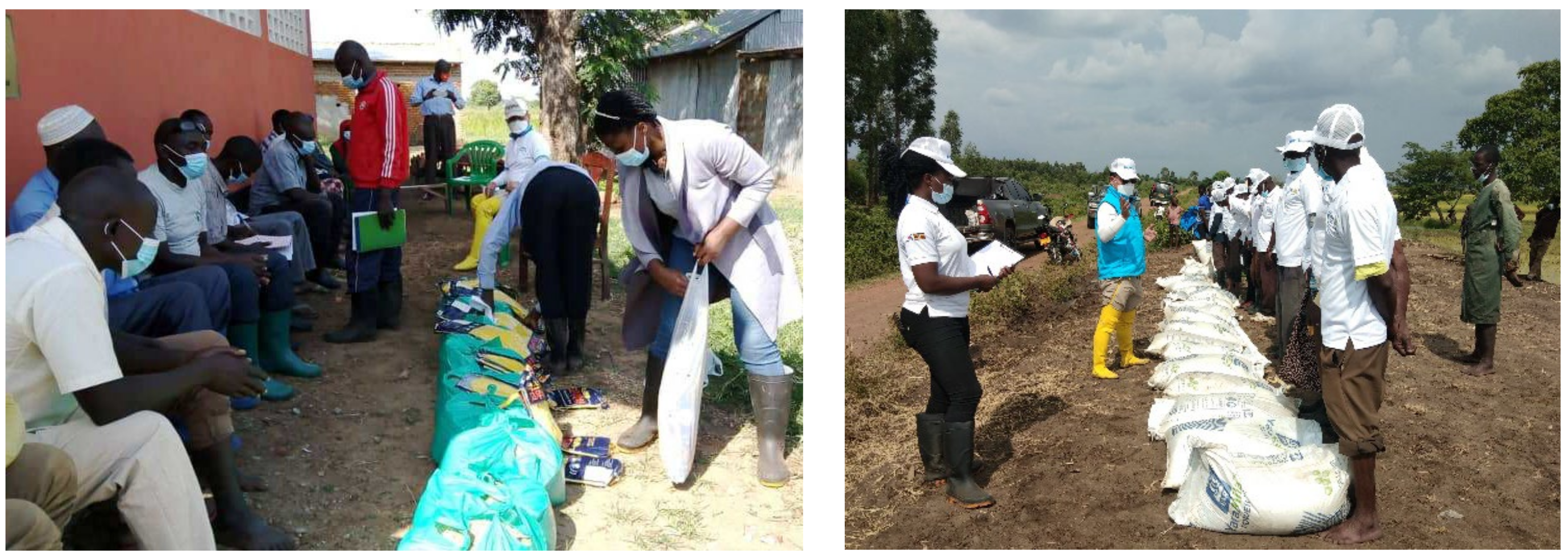
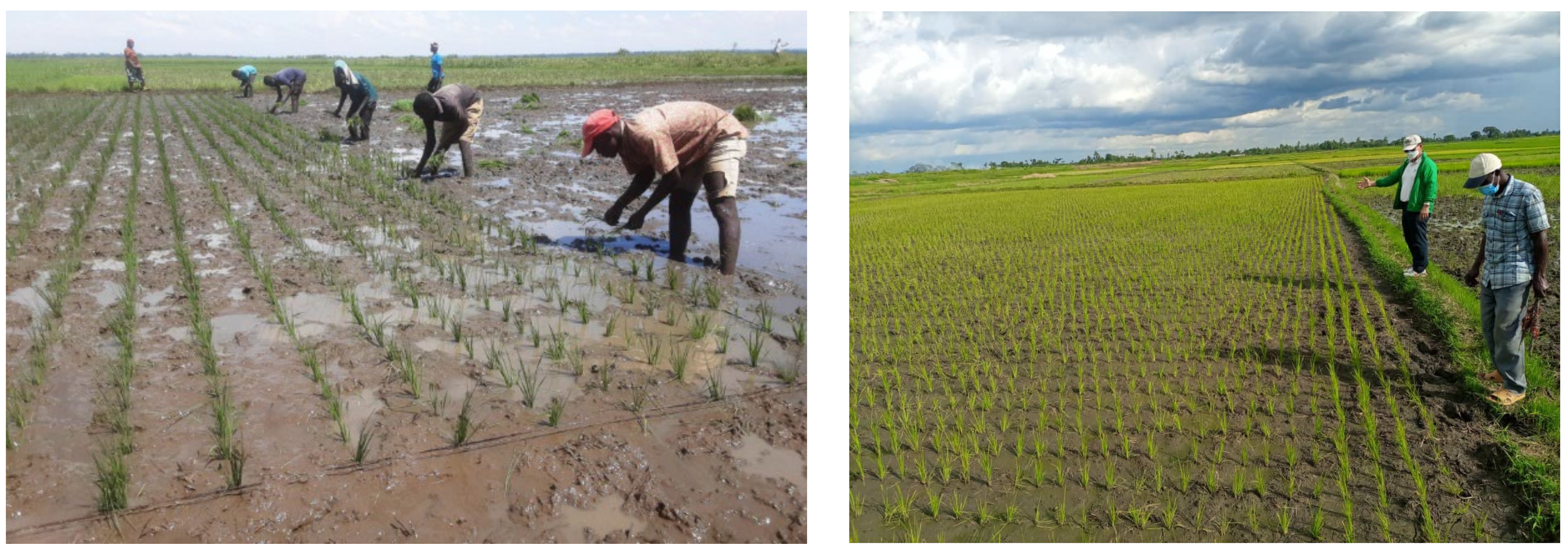
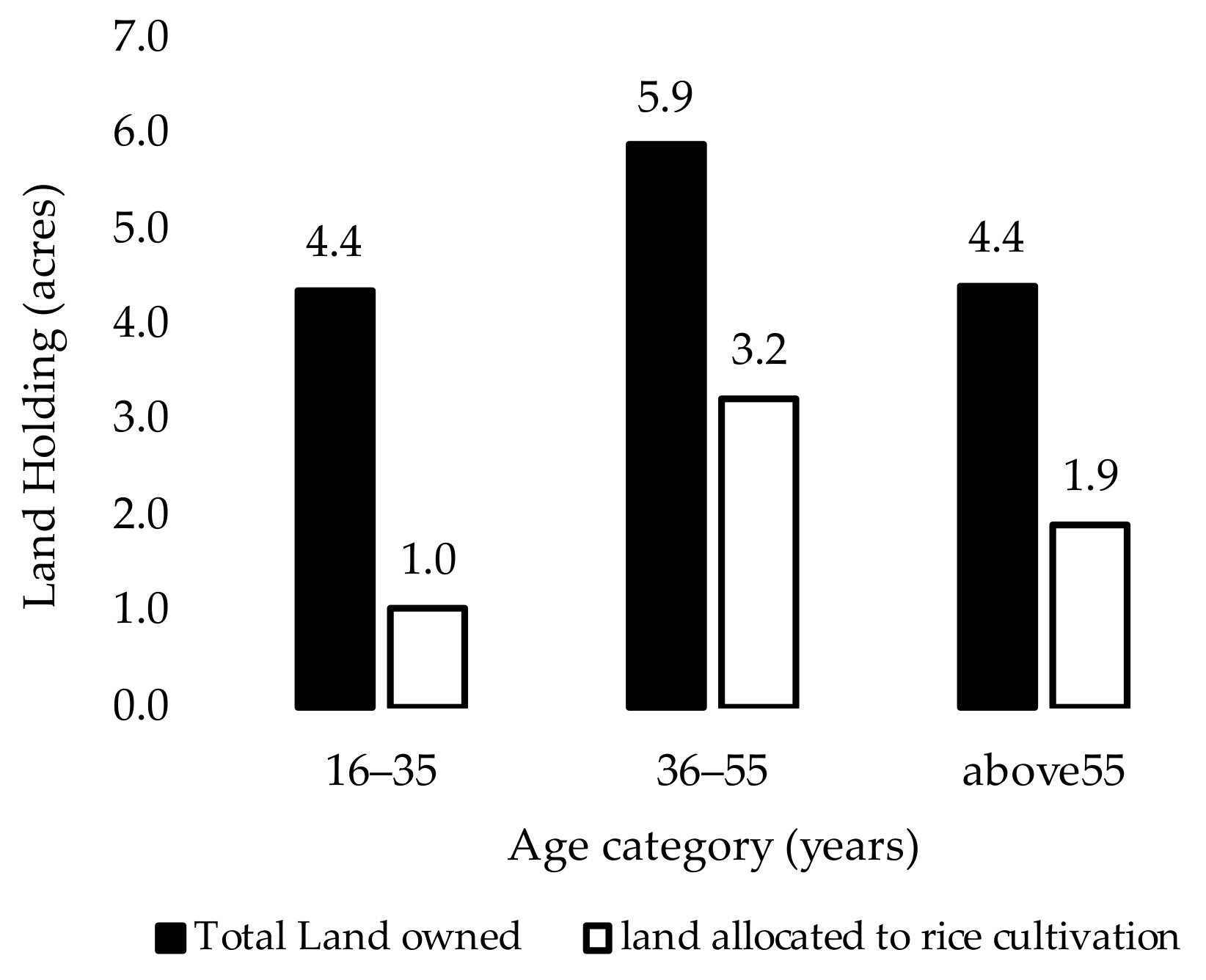
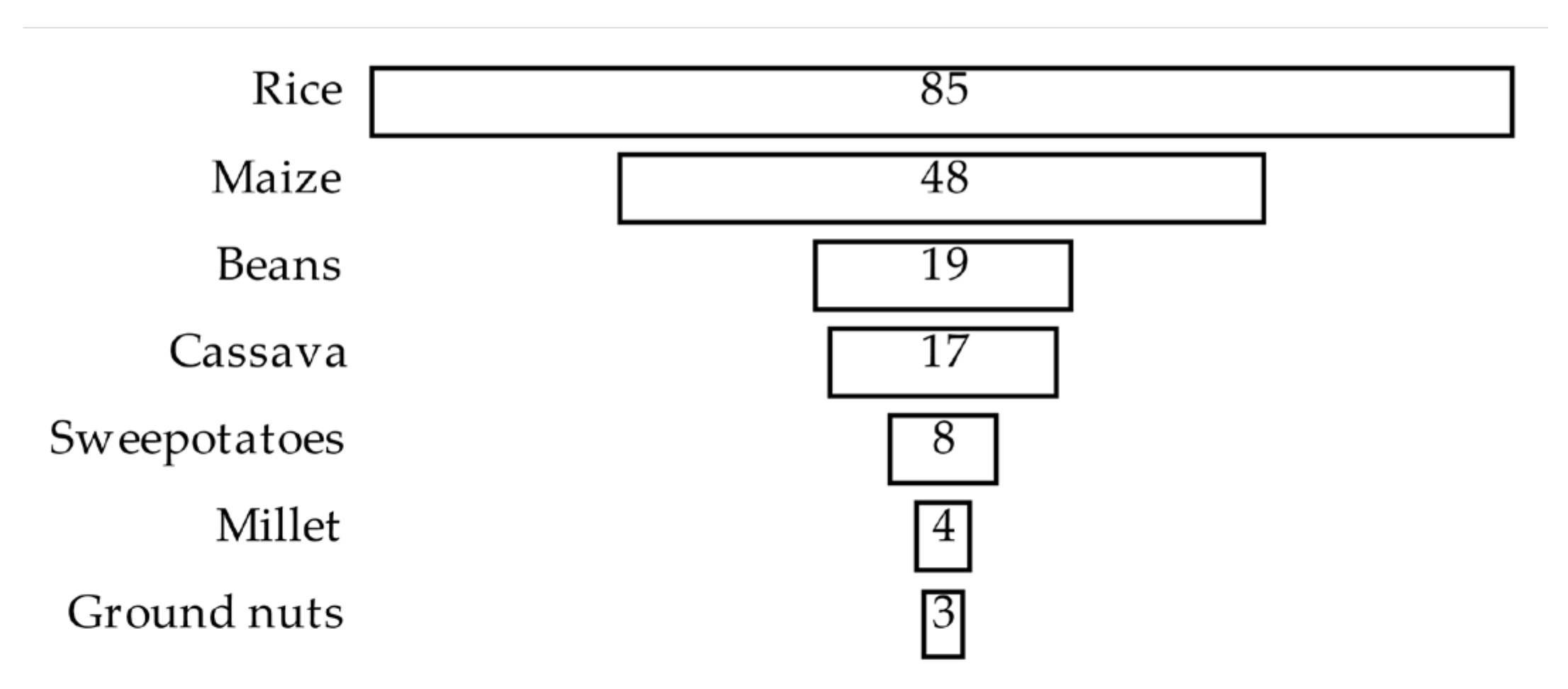
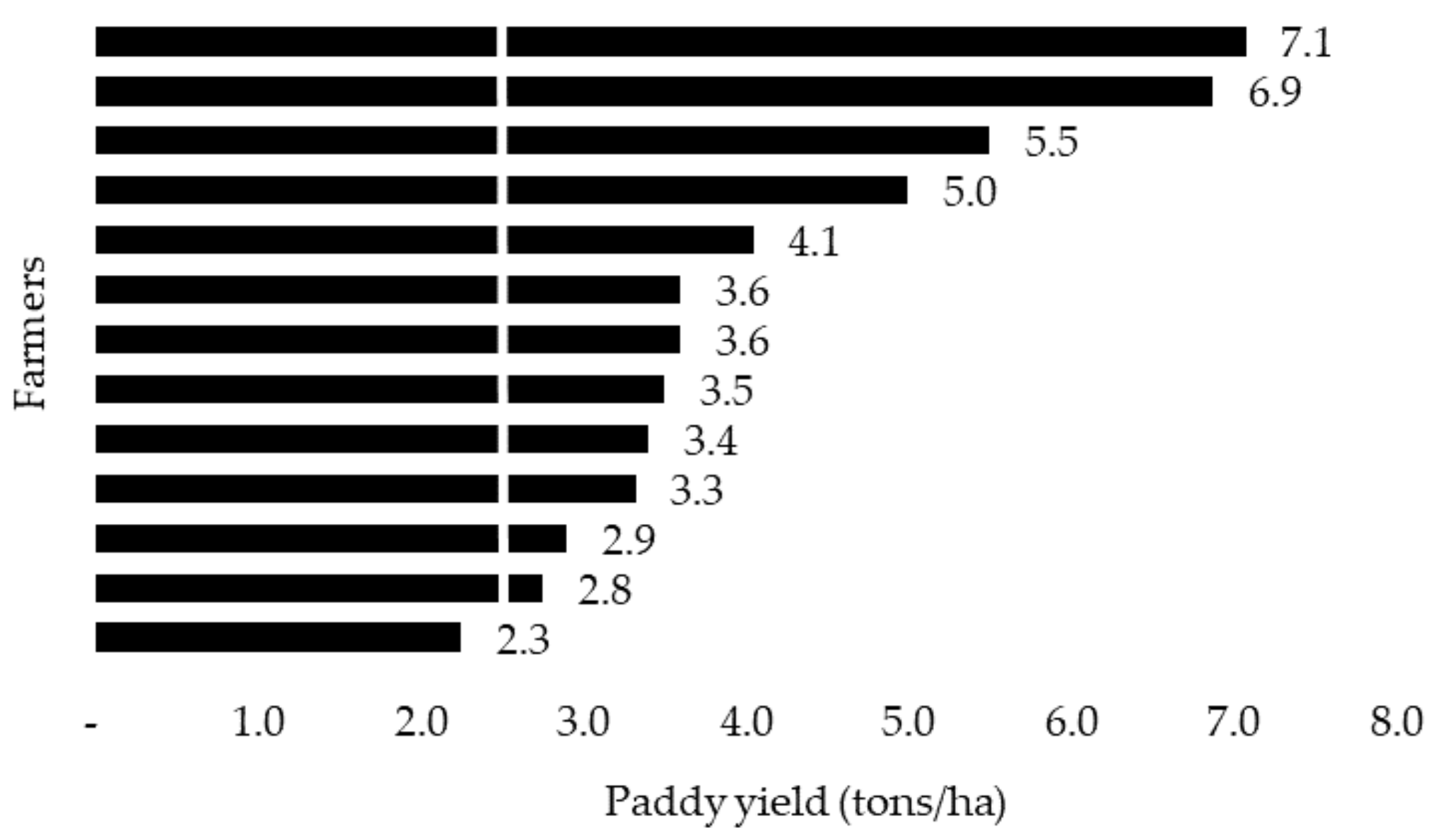
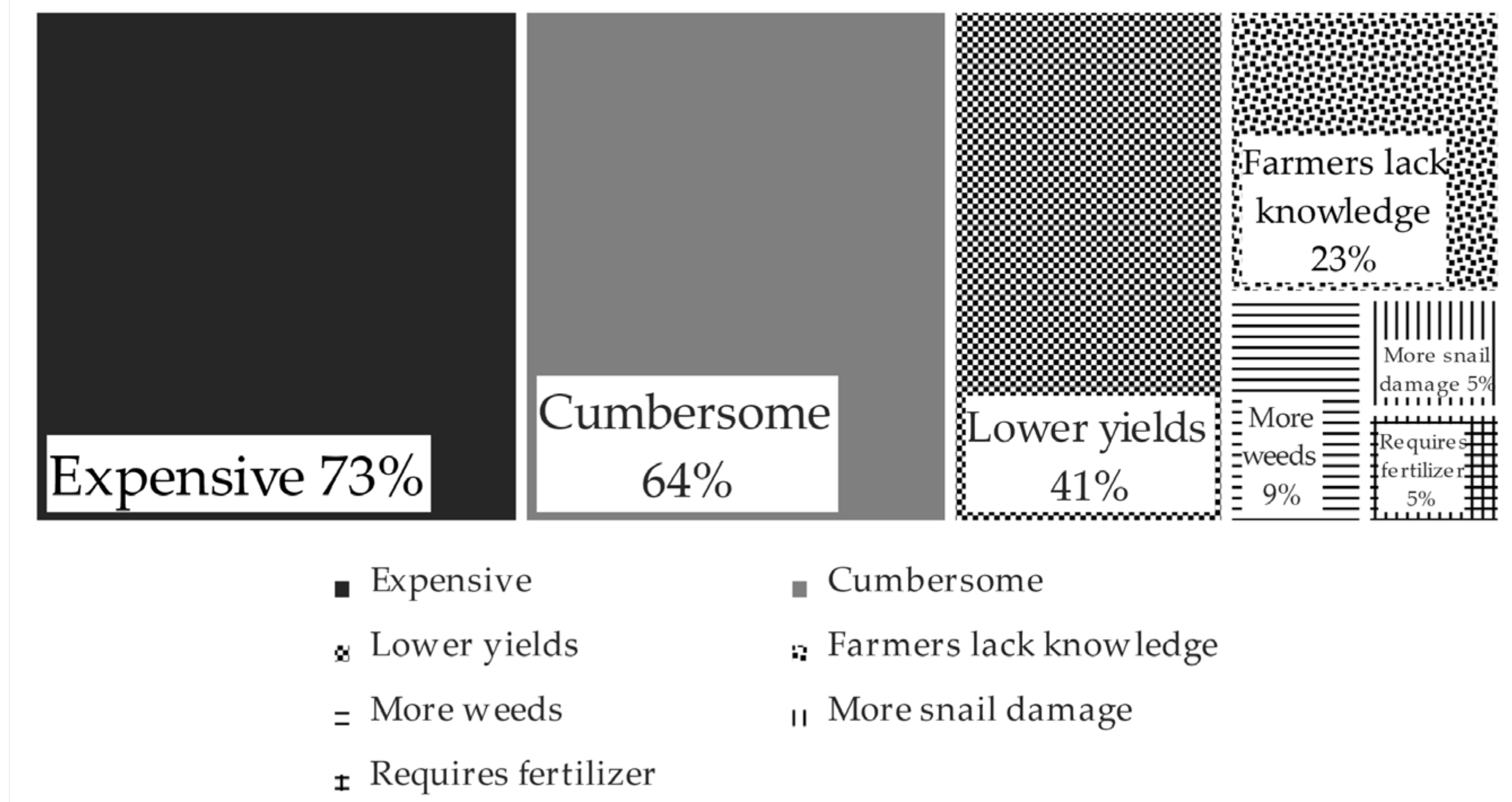
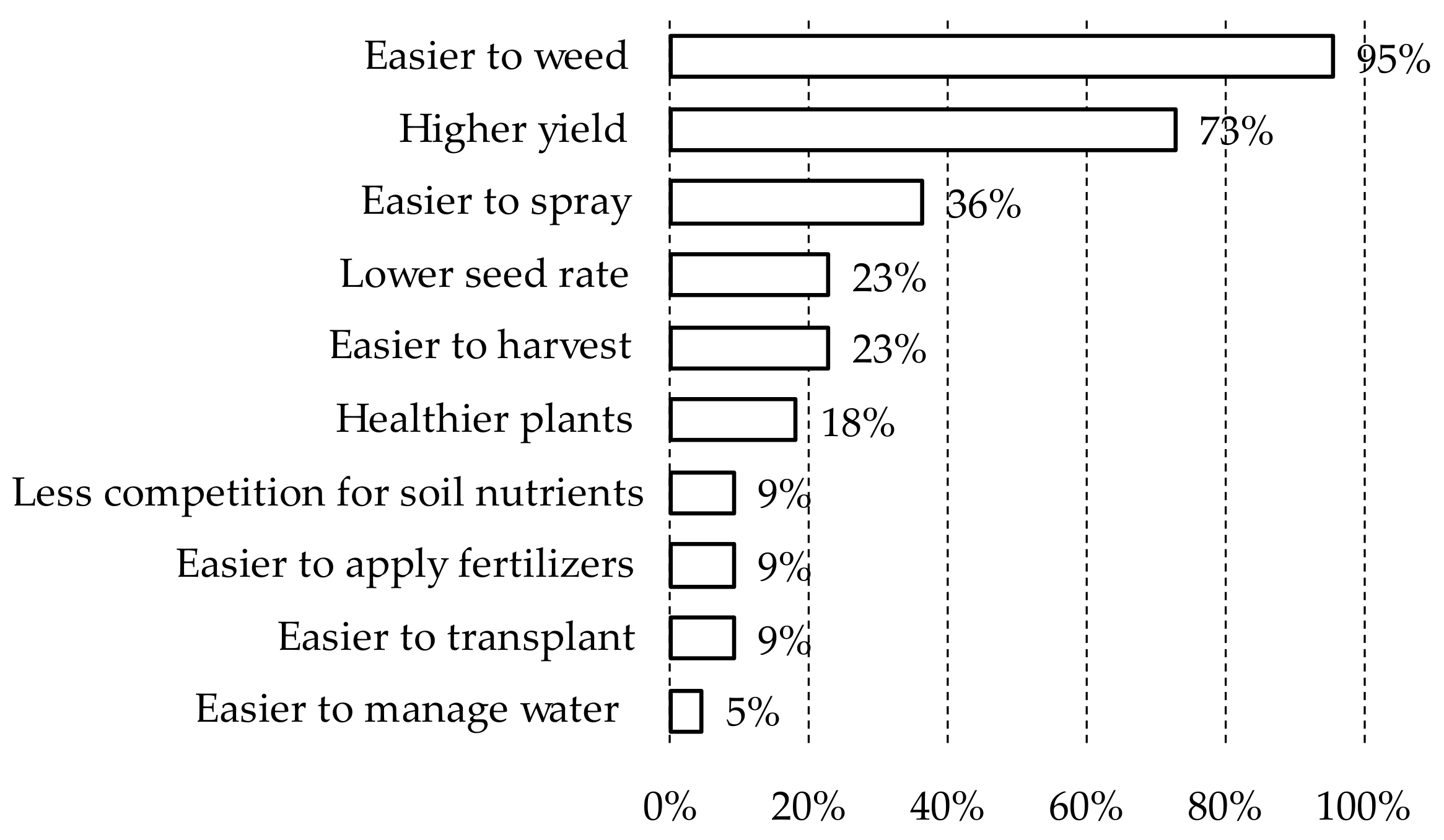
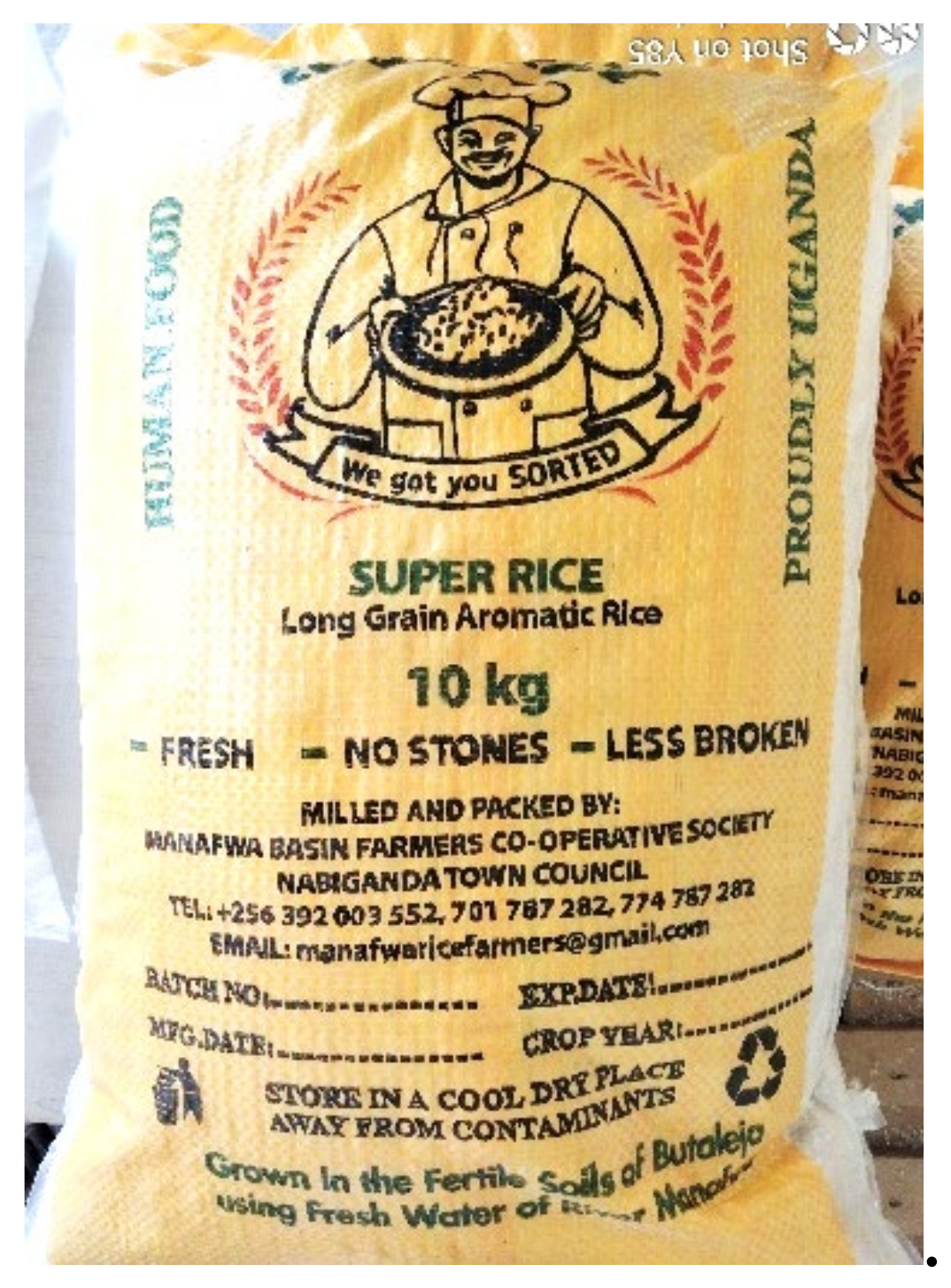
| Variety | Plant Height 60 DAT (cm) | Plant Height at Harvest (cm) | Tiller/Hill 60 DAT | Panicles/Hill | Panicle Length (cm) | Paddy Yield (t/ha) |
|---|---|---|---|---|---|---|
| KAFACI-167 | 72.3 b | 86.5 b | 7.6 c | 18.8 b | 21.0 c | 4.5 b |
| KAFACI-287 | 84.1 a | 112.9 a | 8.6 c | 13.3 c | 25.5 a | 5.2 b |
| NARORICE-1 | 66.3 b | 78.1 c | 11.8 b | 21.8 b | 22.8 b | 6.7 a |
| WITA-9 | 51.6 c | 73.4 c | 17.8 a | 36.8 a | 18.9 d | 8.0 a |
| Mean | 68.6 | 87.8 | 11.5 | 2.3 | 22.0 | 6.1 |
| CV | 7.0 | 4.3 | 10.4 | 18.8 | 5.0 | 19.8 |
| p value | <0.01 | <0.01 | <0.01 | <0.01 | <0.01 | <0.01 |
| LSD (5%) | 6.1 | 4.8 | 1.5 | 5.4 | 1.4 | 1.5 |
| Rank | Challenge | Responses | % Responses |
|---|---|---|---|
| 1 | High cost and shortage of inputs | 16 | 73% |
| 2 | Inadequate irrigation water | 12 | 55% |
| 3 | Pests and diseases | 9 | 41% |
| 4 | Limited mechanization of rice farming | 7 | 32% |
| 5 | Limited farmer access to finance | 6 | 27% |
| 6 | Inadequate farmer’s knowledge of GAPs | 4 | 18% |
| 7 | Limited farmer access to quality inputs | 2 | 9% |
Publisher’s Note: MDPI stays neutral with regard to jurisdictional claims in published maps and institutional affiliations. |
© 2022 by the authors. Licensee MDPI, Basel, Switzerland. This article is an open access article distributed under the terms and conditions of the Creative Commons Attribution (CC BY) license (https://creativecommons.org/licenses/by/4.0/).
Share and Cite
Alibu, S.; Obura, M.; Ekebu, J.; Nampamya, D.; Lamo, J.; Asea, G.; Park, T.-S. Modest Ag-Extension and Access to Seeds of Aromatic Rice Can Boost Returns of Smallholder Farmers in Uganda, A Case Study. Agriculture 2022, 12, 1172. https://doi.org/10.3390/agriculture12081172
Alibu S, Obura M, Ekebu J, Nampamya D, Lamo J, Asea G, Park T-S. Modest Ag-Extension and Access to Seeds of Aromatic Rice Can Boost Returns of Smallholder Farmers in Uganda, A Case Study. Agriculture. 2022; 12(8):1172. https://doi.org/10.3390/agriculture12081172
Chicago/Turabian StyleAlibu, Simon, Morish Obura, James Ekebu, Doreen Nampamya, Jimmy Lamo, Godfrey Asea, and Tae-Seon Park. 2022. "Modest Ag-Extension and Access to Seeds of Aromatic Rice Can Boost Returns of Smallholder Farmers in Uganda, A Case Study" Agriculture 12, no. 8: 1172. https://doi.org/10.3390/agriculture12081172
APA StyleAlibu, S., Obura, M., Ekebu, J., Nampamya, D., Lamo, J., Asea, G., & Park, T.-S. (2022). Modest Ag-Extension and Access to Seeds of Aromatic Rice Can Boost Returns of Smallholder Farmers in Uganda, A Case Study. Agriculture, 12(8), 1172. https://doi.org/10.3390/agriculture12081172






